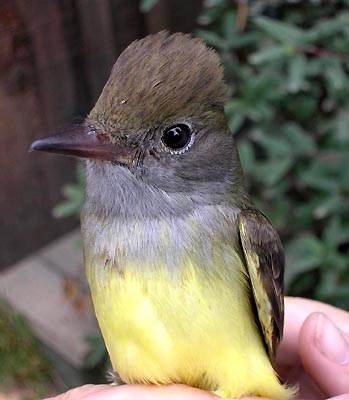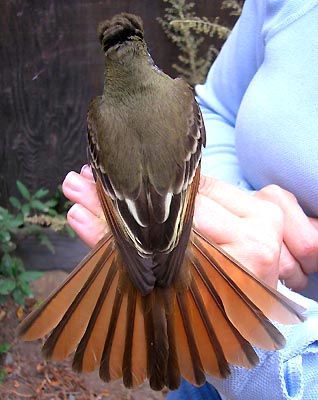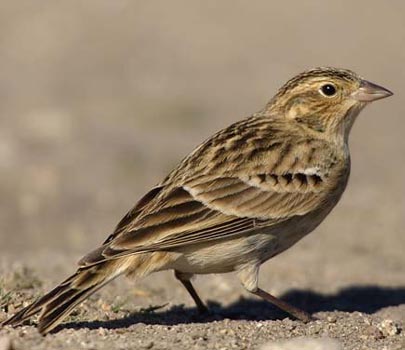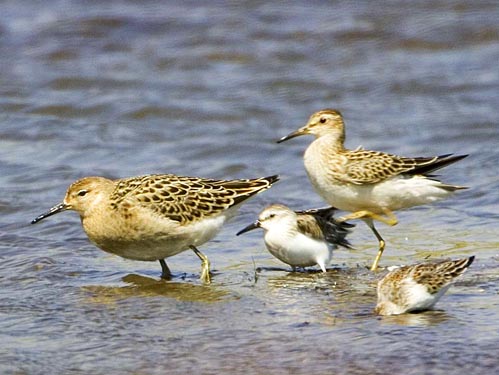| These highlights chronicle the year 2006. Created incrementally as
new photos were available, the year runs generally "backwards" on this
page.
The abbreviation "MTY" means "Monterey County" in the
text below. Text by Don Roberson. Photos on this page are copyrighted
by the photographers to whom they are attributed, and may not be
reproduced in any form (including other web sites) without the express
consent of the photographer. |
| Our year concludes with Christmas Bird Counts (CBC; the Moss Landing
CBC is always on 1 Jan of the next year). Breaks in the weather helped
our two other local counts — Monterey Peninsula and Big Sur — to find many
surprises. |

|
 Perhaps
no bird was more surprising than an adult female Brown Booby found
roosting with cormorants at the tip of Monterey's Coast Guard jetty on
28 Dec, the day of the Monterey Peninsula CBC (above, bird in lower
center; © D. Roberson). The bird was found by visiting birder Dave
Weber, who passed on word to local counters he ran into. The booby remained
to be nicely photographed the following day (left; © Bill Hill). Perhaps
no bird was more surprising than an adult female Brown Booby found
roosting with cormorants at the tip of Monterey's Coast Guard jetty on
28 Dec, the day of the Monterey Peninsula CBC (above, bird in lower
center; © D. Roberson). The bird was found by visiting birder Dave
Weber, who passed on word to local counters he ran into. The booby remained
to be nicely photographed the following day (left; © Bill Hill).
Yet another surprise was the continuing presence of the Blue-winged
Warbler at Carmel River mouth during and after the CBC. Photos of it
earlier in the fall are farther down this page; it is attempting to become
only the second wintering Blue-winged in northern California.
There were further highlights on the Monterey Peninsula CBC on 28 Dec:
an Eastern Phoebe near Esplanade in Pacific Grove discovered by
Rob Fowler & Steve Rovell (photo below left; © Steve Rovell);
a Tundra Swan on the Spanish Bay golf course pond, initially found
a few weeks earlier by Bob Tintle (below center; © D. Roberson); and
the adult Crested Caracara still lingered — this time at Pt. Joe
in Pebble Beach (below right; © D. Roberson). Presumably this is the
same adult that has commuted between Pt. Sur and Ft. Ord, sometimes hitting
the outer Monterey Peninsula enroute, since March. |
|
|
 The
Big
Sur CBC on 17 Dec was also quite successful. Two Ross's Geese
(left; © Steve Rovell) were among a long list of rarities. Other treats
included Thick-billed Murre from Pt. Sur (Matt Brady) and Sage
Thrasher at Big Sur R. mouth (Rovell), plus Red-naped Sapsucker,
Eastern
Phoebe, and the Crested Caracara that has been in the Pt. Sur
vicinity since March. The
Big
Sur CBC on 17 Dec was also quite successful. Two Ross's Geese
(left; © Steve Rovell) were among a long list of rarities. Other treats
included Thick-billed Murre from Pt. Sur (Matt Brady) and Sage
Thrasher at Big Sur R. mouth (Rovell), plus Red-naped Sapsucker,
Eastern
Phoebe, and the Crested Caracara that has been in the Pt. Sur
vicinity since March. |
|
 Brian
Sullivan's reports of sea-watching from Pt. Pinos were among the highlights
of the autumn. In early December he had a Thick-billed Murre fly
past, then had small flights of Marbled Murrelet on 17 Dec (9) and
19 Dec (11), and throughout the late fall he observed a strong passage
of Ancient Murrelet (up to 57 on 17 Dec). Aerial surveys shortly
thereafter found 250 between Pt. Pinos and Bixby Bridge (Jeff Davis). Brian
Sullivan's reports of sea-watching from Pt. Pinos were among the highlights
of the autumn. In early December he had a Thick-billed Murre fly
past, then had small flights of Marbled Murrelet on 17 Dec (9) and
19 Dec (11), and throughout the late fall he observed a strong passage
of Ancient Murrelet (up to 57 on 17 Dec). Aerial surveys shortly
thereafter found 250 between Pt. Pinos and Bixby Bridge (Jeff Davis).
Sullivan's sea-watching also led to some landbird finds, including this
vagrant Burrowing Owl, found in October, that remained to be photo-documented
for the Monterey Peninsula CBC on 28 Dec (right © D. Roberson). |
|
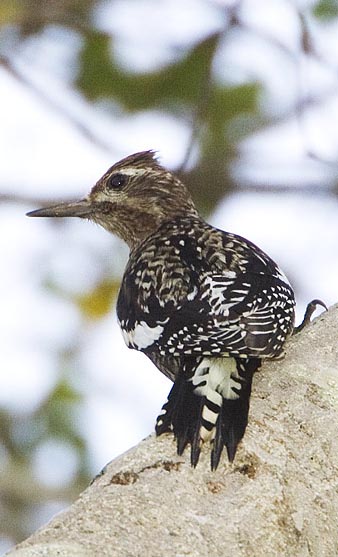 |
Late fall vagrants included one — or two (still needs to be determined)
— juvenal Yellow-bellied Sapsucker in San Carlos Cemetery, El Estero,
Monterey, found the weekend of 9-10 December (Matt Brady, Ryan Terrill
et al.). Bill Hill's fine photo (left) shows a juv. female he found on
10 Dec; it would remain to year's end. A great yard bird was an American
Tree Sparrow at Kent & Karen Van Vuren's Prunedale feeder 12-13
November. Steve Rovell got this snap (below) on its final day of appearance.
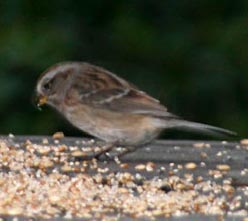
|
|
 One
cool aspect of fall migration is that you never quite know what to expect.
Stan Dryden was searching for small vagrant passerines in a willow patch
near the Carmel R. mouth on 10 Nov, and instead noticed a colorful "stump"
that turned into this Long-eared Owl! (right; photo © Stan
Dryden). This proved to be the first record for the Carmel River mouth
listing area. One
cool aspect of fall migration is that you never quite know what to expect.
Stan Dryden was searching for small vagrant passerines in a willow patch
near the Carmel R. mouth on 10 Nov, and instead noticed a colorful "stump"
that turned into this Long-eared Owl! (right; photo © Stan
Dryden). This proved to be the first record for the Carmel River mouth
listing area.
The Big Sur Ornithology Lab, operated by Ventana Wildlife Society, has
just forwarded photos of its best capture of the fall (below): a Great
Crested Flycatcher on 13 Oct. This was the 5th record for MTY: three
at Big Sur R. mouth and two at Carmel River mouth. The great spread tail
shot shows that the inner webs of each rectrix (except the middle two)
are rusty all the way to the tip, ruling out Ash-throated Flycatcher (whose
dark outer webs expand at the tail tip to 'cut off' the inner web). |
|
|
| Late October and early November invariably bring scarce geese into
MTY. A taxa that we are finding much more often in recent years is the
"Aleutian" subspecies of Cackling Goose, Branta minima
leucopareia. This subspecies has a white neck ring as an adult (juvenal
birds lack this feature), and differs from "minima" Cackling Geese by paler
breast, details of head shape and bill size, and a slightly larger body
size. At the time of the publication of Monterey Birds (2002), the
largest flock ever in MTY was 7 birds. On 27-28 Oct 2006, a flock of 11
"Aleutian" geese rested at the Odello restoration area at Carmel R. mouth.
Ten of the 11 birds can be seen in the photo below (© D. Roberson).
Other "Aleutian" Cackling Geese have recently been at Crespi Pond
and Lake El Estero, Monterey. This taxa was once on the Endangered species
list but has rebounded very well after predators were removed from their
breeding islands. |
|

|
|
|
 On
27 Oct, Matt Brady discovered a Blue-winged Warbler in a restricted-access
"Odello Habitat Restoration Area" while doing surveys for Ventana Wildlife
Society's Big Sur Ornithology Lab. This was just the 4th MTY record, and
the second for Carmel River mouth, but these are the first photos taken
of a bird 'in-the-wild' in MTY. It was photographed on 28 Oct (above left;
© D. Roberson) and then lingered locally through December! There is
a chance that it will winter — there is the precedent of one wintering
in Humboldt County in the early 1990s. On
27 Oct, Matt Brady discovered a Blue-winged Warbler in a restricted-access
"Odello Habitat Restoration Area" while doing surveys for Ventana Wildlife
Society's Big Sur Ornithology Lab. This was just the 4th MTY record, and
the second for Carmel River mouth, but these are the first photos taken
of a bird 'in-the-wild' in MTY. It was photographed on 28 Oct (above left;
© D. Roberson) and then lingered locally through December! There is
a chance that it will winter — there is the precedent of one wintering
in Humboldt County in the early 1990s.
Brady also discovered a Nelson's Sharp-tailed Sparrow at the
restricted-access Odello Lagoon earlier on 27 Oct, and it lingered into
the next week (photo above right 28 Oct, © Bill Hill). On 29 Oct,
an imm female Magnolia Warbler was at Elkhorn Slough National Estuarine
Research Reserve, a first record there (photo left, © D. Roberson). |
|
| On 23 October, Bob Tintle discovered two immature Chestnut-collared
Longspurs near Pt. Joe in Pebble Beach. This is the first record for
the Monterey Peninsula for this species, with has otherwise only been found
on-shore in fields east of Gonzales in late autumn. Photos of the two birds
are below: male © John Sorensen (left) and female © Don Roberson
(right). The male was till present the next day.
|
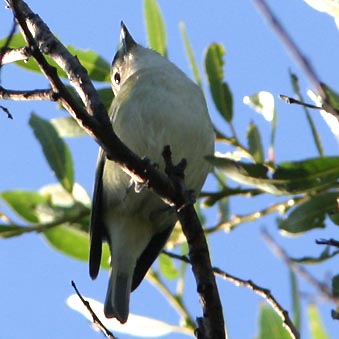 A
smattering of highlight birds enlivened the weekend of 7-8 Oct. At Big
Sur River mouth, a Plumbeous Vireo (left; © D. Roberson) at
the north headlands patch was singing a rather fast, burry song (in comparison
with other 'Solitary' Vireo types); it was fresh, plain gray above with
a slight wash of yellow to the flanks, and short-tailed with a broad white
edge to outer rectrices. Meanwhile, Scott & Linda Terrill saw a Broad-winged
Hawk over the campground. More usual vagrants included two Blackpolls,
2 Black-and-whites, a Tennessee, and a Palm (DR, Terrills, M. Tyner); the
Terrills later had a Black-throated Green Warbler at Carmel River
mouth. On the Monterey Peninsula, Susan Steele found an immature Lapland
Longspur (below © D. Roberson) on 7 Oct that skulked in ocean
edge grass at Rocky Shores in Pacific Grove. Given its location, it likely
flew in off the ocean. It seemed famished and was feeding voraciously on
grass seeds. A
smattering of highlight birds enlivened the weekend of 7-8 Oct. At Big
Sur River mouth, a Plumbeous Vireo (left; © D. Roberson) at
the north headlands patch was singing a rather fast, burry song (in comparison
with other 'Solitary' Vireo types); it was fresh, plain gray above with
a slight wash of yellow to the flanks, and short-tailed with a broad white
edge to outer rectrices. Meanwhile, Scott & Linda Terrill saw a Broad-winged
Hawk over the campground. More usual vagrants included two Blackpolls,
2 Black-and-whites, a Tennessee, and a Palm (DR, Terrills, M. Tyner); the
Terrills later had a Black-throated Green Warbler at Carmel River
mouth. On the Monterey Peninsula, Susan Steele found an immature Lapland
Longspur (below © D. Roberson) on 7 Oct that skulked in ocean
edge grass at Rocky Shores in Pacific Grove. Given its location, it likely
flew in off the ocean. It seemed famished and was feeding voraciously on
grass seeds. |
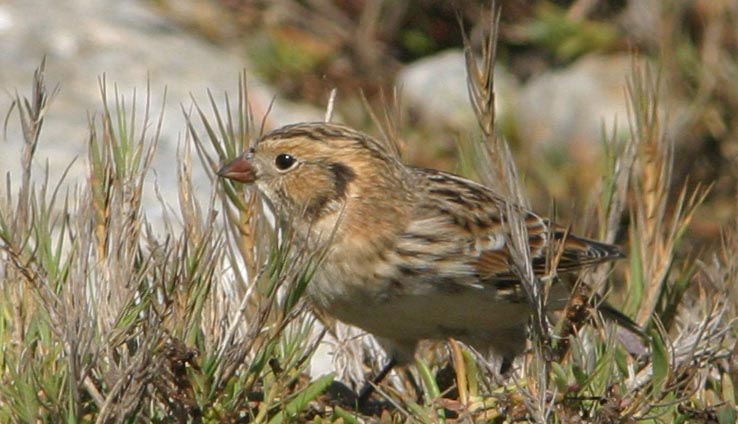
|
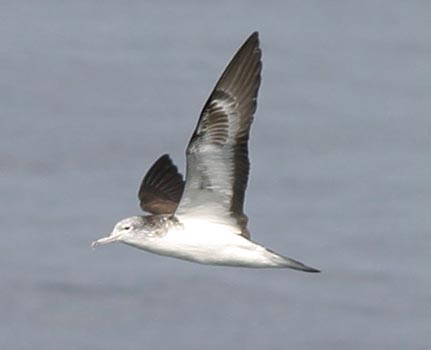 Monterey
Bay was quite good for seabirds in September, and particularly during flat
calm seas on the final weekend of the month. The best bird was this
Streaked Shearwater on 30 Sep (photo right © Brian L.
Sullivan), found by Scott Terrill. It was about 8 miles west of Cypress
Pt. for the 8th MTY record, all of them in Sept-Oct. Yet another Streaked
Shearwater was in mid-Bay on 15 Sep, seen in both MTY & SCZ, as
was a Greater Shearwater that date (both Shearwater Journeys). Monterey
Bay was quite good for seabirds in September, and particularly during flat
calm seas on the final weekend of the month. The best bird was this
Streaked Shearwater on 30 Sep (photo right © Brian L.
Sullivan), found by Scott Terrill. It was about 8 miles west of Cypress
Pt. for the 8th MTY record, all of them in Sept-Oct. Yet another Streaked
Shearwater was in mid-Bay on 15 Sep, seen in both MTY & SCZ, as
was a Greater Shearwater that date (both Shearwater Journeys).
In the tw-plus months between 1 Aug and 22 Oct there were 15
reports of Manx Shearwater (10 in MTY, 5 in SCZ). This is the most
reported in a season since the halcyon days of the 1990s, when there were
10+ in fall 1994, 12+ in fall 1996, and 8 in 1999 (in each year about 2
were in SCZ, the rest in MTY). Also of note was the storm-petrel flocks
in the SCZ portions of the Bay, peaking at up to 8000 Ashy (including a
couple leucistic ones), 450 Black, 6 Least, 2-3 Wilson's, and a Fork-tailed
on various dates in September. Strong numbers of South Polar Skua, all
3 jaegers, and Sabine's Gull were encountered. By the end of September
the occasional flock of a dozen or more Pomarine Jaegers sitting together
on flat seas was encountered.
Humpback Whales also put on a show; click
here for photos. |
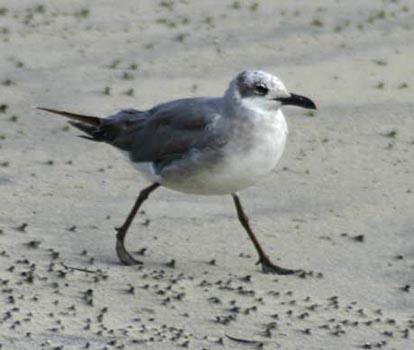 Many
good birds were at the Big Sur River mouth in September, and none better
than this Laughing Gull (left) on 21 Sep, a first for Andrew Molera
State Park. It was found by and photographed © Waldo Holt. Many
good birds were at the Big Sur River mouth in September, and none better
than this Laughing Gull (left) on 21 Sep, a first for Andrew Molera
State Park. It was found by and photographed © Waldo Holt.
Another impressive bird was the reappearance of the Crested Caracara
here in September, near where it was first found in late March (see earlier
pages of these highlights). During the spring and summer this adult
Caracara was seen wandering around the Monterey Peninsula vicinity, being
seen off-and-on at the Carmel River mouth, in Pebble Beach and Pacific
Grove, and north to Ft. Ord and the Salinas River mouth.
Among migrant landbirds, Big Sur River mouth hosted Canada and Prairie
Warblers in September, plus Red-eyed Vireo and Black-throated Sparrow,
multiple Magnolia and Chestnut-sided Warblers, a host of lesser 'eastern'
species, and lingering Chimney Swifts from the summer (Matt Brady, Ryan
Terrill, Mike Tyner, Tim Amaral, Carole & Larry Rose, and others). |

|
Early September brings the beginnings of autumn landbird migration,
and its chances for vagrants and scarce species. One of the first to appear
annually in Northern Waterthrush, and often first spotted at the
Carmel River mouth. This year was no exception, with Scott & Linda
Terrill finding the first waterthrush of the fall on 9 Sep [above; photo
10 Sep © D. Roberson]. Other 'eastern' species found over that first
weekend including Northern Parula, Magnolia, Chestnut-sided, and Blackpoll
Warblers (and several other species reported only third-hand — we need
those to be reported directly), and Bobolink (the Terrills, Rick Fournier,
Mike Tyner, Linda Parker et al.).
Shorebird migration continued to peak in early September,
with juvenal Ruffs found at Moonglow Dairy 8-11 Sep (photo ©
Roger Wolfe, below left) and in the restricted areas near Carmel River
mouth 7 Sep (photo © Bill Hill, below right). I like Bill Hill's shot
that make it look like the Ruff, a Western Sandpiper, and a Pectoral Sandpiper
are all leaning into a nor'eastern blizzard . . . |
|
|
|
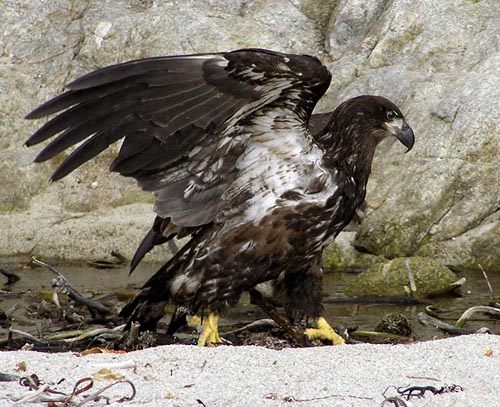 A
remarkable find at Pt. Lobos on 4 Sep was this juvenal Bald Eagle [right;
photo © Laura Carley], seemingly playing with kelp along the shore.
Laura Carley writes that it was "hopping around in the stream, mock hunting,
and pulling up sticks & kelp weeds." Presumably this same eagle had
been seen a couple of days before at Carmel R. mouth (Stan Dryden). Since
our wintering eagles don't arrive until October or November, it is my guess
that this youngster was hatched from a central coast nest somewhere nearby.
There were four known nests in southern MTY this year (fide Sal Lucido,
Ventana Wildlife Society). A
remarkable find at Pt. Lobos on 4 Sep was this juvenal Bald Eagle [right;
photo © Laura Carley], seemingly playing with kelp along the shore.
Laura Carley writes that it was "hopping around in the stream, mock hunting,
and pulling up sticks & kelp weeds." Presumably this same eagle had
been seen a couple of days before at Carmel R. mouth (Stan Dryden). Since
our wintering eagles don't arrive until October or November, it is my guess
that this youngster was hatched from a central coast nest somewhere nearby.
There were four known nests in southern MTY this year (fide Sal Lucido,
Ventana Wildlife Society). |
|
There were so many photographs to be highlighted between January
and August 2006 that they've taken up two web pages, and it is now time
to start a third featuring Fall 2006. We'll start with a rarity that appeared
at the very end of August. What are these birders focused on?
|
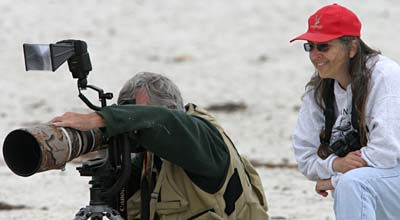
Yes, the Big Lens is being man-handled by Bill Hill whilst Rita Carratello
observes with interest. Apparently they've both focused on a little sandpiper
(right), a nice vagrant to start of the 'official' fall season. To see
the photo Bill Hill was taking, check
his web site. Brian Sullivan also has a picture on
his web pages.
The bird is a juvenal Buff-breasted Sandpiper, found by Brian
Weed on 28 August on Asilomar State Beach. It seemed oblivious to the hordes
of beach walkers, and even their dogs (but not to a Peregrine Falcon that
flushed it off the beach for several hours). It seemed to be dining on
sand flies among the rotting kelp. Yet another shot is below (© D.
Roberson). |
 |

|
|
This is about the 20th record of Buff-breasted Sandpiper in MTY.
All have been in juvenal plumage and all were discovered within the one
month 'window' between 14 Aug-15 Sep. This is consistent with its status
elsewhere in California.
|
|
|
|
 Perhaps
no bird was more surprising than an adult female Brown Booby found
roosting with cormorants at the tip of Monterey's Coast Guard jetty on
28 Dec, the day of the Monterey Peninsula CBC (above, bird in lower
center; © D. Roberson). The bird was found by visiting birder Dave
Weber, who passed on word to local counters he ran into. The booby remained
to be nicely photographed the following day (left; © Bill Hill).
Perhaps
no bird was more surprising than an adult female Brown Booby found
roosting with cormorants at the tip of Monterey's Coast Guard jetty on
28 Dec, the day of the Monterey Peninsula CBC (above, bird in lower
center; © D. Roberson). The bird was found by visiting birder Dave
Weber, who passed on word to local counters he ran into. The booby remained
to be nicely photographed the following day (left; © Bill Hill).
 One
cool aspect of fall migration is that you never quite know what to expect.
Stan Dryden was searching for small vagrant passerines in a willow patch
near the Carmel R. mouth on 10 Nov, and instead noticed a colorful "stump"
that turned into this Long-eared Owl! (right; photo © Stan
Dryden). This proved to be the first record for the Carmel River mouth
listing area.
One
cool aspect of fall migration is that you never quite know what to expect.
Stan Dryden was searching for small vagrant passerines in a willow patch
near the Carmel R. mouth on 10 Nov, and instead noticed a colorful "stump"
that turned into this Long-eared Owl! (right; photo © Stan
Dryden). This proved to be the first record for the Carmel River mouth
listing area.
 Monterey
Bay was quite good for seabirds in September, and particularly during flat
calm seas on the final weekend of the month. The best bird was this
Streaked Shearwater on 30 Sep (photo right © Brian L.
Sullivan), found by Scott Terrill. It was about 8 miles west of Cypress
Pt. for the 8th MTY record, all of them in Sept-Oct. Yet another Streaked
Shearwater was in mid-Bay on 15 Sep, seen in both MTY & SCZ, as
was a Greater Shearwater that date (both Shearwater Journeys).
Monterey
Bay was quite good for seabirds in September, and particularly during flat
calm seas on the final weekend of the month. The best bird was this
Streaked Shearwater on 30 Sep (photo right © Brian L.
Sullivan), found by Scott Terrill. It was about 8 miles west of Cypress
Pt. for the 8th MTY record, all of them in Sept-Oct. Yet another Streaked
Shearwater was in mid-Bay on 15 Sep, seen in both MTY & SCZ, as
was a Greater Shearwater that date (both Shearwater Journeys).
 Many
good birds were at the Big Sur River mouth in September, and none better
than this Laughing Gull (left) on 21 Sep, a first for Andrew Molera
State Park. It was found by and photographed © Waldo Holt.
Many
good birds were at the Big Sur River mouth in September, and none better
than this Laughing Gull (left) on 21 Sep, a first for Andrew Molera
State Park. It was found by and photographed © Waldo Holt.
 A
remarkable find at Pt. Lobos on 4 Sep was this juvenal Bald Eagle [right;
photo © Laura Carley], seemingly playing with kelp along the shore.
Laura Carley writes that it was "hopping around in the stream, mock hunting,
and pulling up sticks & kelp weeds." Presumably this same eagle had
been seen a couple of days before at Carmel R. mouth (Stan Dryden). Since
our wintering eagles don't arrive until October or November, it is my guess
that this youngster was hatched from a central coast nest somewhere nearby.
There were four known nests in southern MTY this year (fide Sal Lucido,
Ventana Wildlife Society).
A
remarkable find at Pt. Lobos on 4 Sep was this juvenal Bald Eagle [right;
photo © Laura Carley], seemingly playing with kelp along the shore.
Laura Carley writes that it was "hopping around in the stream, mock hunting,
and pulling up sticks & kelp weeds." Presumably this same eagle had
been seen a couple of days before at Carmel R. mouth (Stan Dryden). Since
our wintering eagles don't arrive until October or November, it is my guess
that this youngster was hatched from a central coast nest somewhere nearby.
There were four known nests in southern MTY this year (fide Sal Lucido,
Ventana Wildlife Society).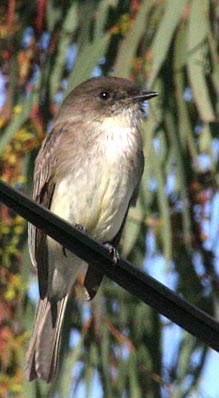
 The
Big
Sur CBC on 17 Dec was also quite successful. Two Ross's Geese
(left; © Steve Rovell) were among a long list of rarities. Other treats
included Thick-billed Murre from Pt. Sur (Matt Brady) and Sage
Thrasher at Big Sur R. mouth (Rovell), plus Red-naped Sapsucker,
Eastern
Phoebe, and the Crested Caracara that has been in the Pt. Sur
vicinity since March.
The
Big
Sur CBC on 17 Dec was also quite successful. Two Ross's Geese
(left; © Steve Rovell) were among a long list of rarities. Other treats
included Thick-billed Murre from Pt. Sur (Matt Brady) and Sage
Thrasher at Big Sur R. mouth (Rovell), plus Red-naped Sapsucker,
Eastern
Phoebe, and the Crested Caracara that has been in the Pt. Sur
vicinity since March.

